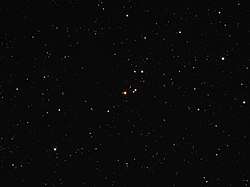SU Andromedae
SU Andromedae is a carbon star in the constellation of Andromeda. It is a variable star classified as a slow irregular pulsating supergiant, and varies from an apparent visual magnitude of 8.5 at minimum brightness to a magnitude of 8.0 at maximum brightness with no clear period.[2]
 SU Andromedae in optical light | |
| Observation data Epoch J2000.0 Equinox J2000.0 | |
|---|---|
| Constellation | Andromeda |
| Right ascension | 00h 04m 36.4076s[1] |
| Declination | +43° 33′ 04.7264″[1] |
| Apparent magnitude (V) | 8.0 to 8.5[2] |
| Characteristics | |
| Spectral type | C6,4(C5II)[2] |
| U−B color index | +4.13[3] |
| B−V color index | +2.58[3] |
| Variable type | LC[2] |
| Astrometry | |
| Proper motion (μ) | RA: −3.362±0.058 [1] mas/yr Dec.: −2.097±0.040 [1] mas/yr |
| Parallax (π) | 0.6979 ± 0.0439[1] mas |
| Distance | 4,700 ± 300 ly (1,430 ± 90 pc) |
| Absolute magnitude (MV) | −2.2[4] |
| Details | |
| SU And | |
| Luminosity | 2,535[5] L☉ |
| Temperature | 2,905[5] K |
| co-moving companion | |
| Radius | 1.95[6] R☉ |
| Luminosity | 9.833[6] L☉ |
| Temperature | 7,311[6] K |
| Other designations | |
| Database references | |
| SIMBAD | data |
Variability
Thomas Espin noted the possible variability of this star in 1895.[7] Williamina Fleming, in 1906, was examining photographic plates taken for the purpose of creating the Henry Draper Catalogue when she independently discovered and confirmed it as a variable star.[8]
Spectrum
The spectrum of SU Andromedae is dominated by Swan bands from the molecule C2. These stars were classified as type N under the Harvard scheme, stars with the blue continuum completely obscured by molecular absorption bands. Carbon star spectral types were later refined in the Morgan-Keenan system and SU Andromedae was typically classified as C64,[9] indicating a fairly cool carbon star and the subscript 4 showing modest Swan band intensity.[10]
Under the modern revised Morgan-Keenan system, SU Andromedae is classified as C-N5 C26-.[11] The C-N spectral type is to distinguish those stars from the C-R type where the blue continuum is not entirely hidden by absorption bands. A classification based on the infrared spectrum is C5 II, again a moderately cool carbon star with a luminosity class of II for a bright giant.[3]
Companion
SU Andromedae is 22" from a magnitude 12.77 star, probably an F0 main sequence star. This star has a Gaia Data Release 2 parallax of 0.7479±0.0905[6] and an absolute magnitude of about +2.4. It has an almost identical space motion as SU Andromedae and is assumed to be a distant co-moving companion. Based on that assumption, the absolute magnitude of SU Andromedae is calculated to be about −2.2.[4]
References
- Brown, A. G. A.; et al. (Gaia collaboration) (August 2018). "Gaia Data Release 2: Summary of the contents and survey properties". Astronomy & Astrophysics. 616. A1. arXiv:1804.09365. Bibcode:2018A&A...616A...1G. doi:10.1051/0004-6361/201833051. Gaia DR2 record for this source at VizieR.
- N. N. Samus; O. V. Durlevich; et al. "SU And database entry". Combined General Catalog of Variable Stars (GCVS4.2, 2004 Ed.). CDS. Retrieved 2018-10-14.
- Richer, Harvey B. (1971). "Some Intrinsic Properties of Carbon Stars". Astrophysical Journal. 167: 521–535. Bibcode:1971ApJ...167..521R. doi:10.1086/151049.
- Olson, B. I.; Richer, H. B. (1975). "The absolute magnitudes of carbon stars - Carbon stars in binary systems". Astrophysical Journal. 200: 88–94. Bibcode:1975ApJ...200...88O. doi:10.1086/153763.
- Bergeat, J.; Knapik, A.; Rutily, B. (2002). "Carbon-rich giants in the HR diagram and their luminosity function". Astronomy and Astrophysics. 390 (3): 967–986. Bibcode:2002A&A...390..967B. doi:10.1051/0004-6361:20020525.
- Brown, A. G. A.; et al. (Gaia collaboration) (August 2018). "Gaia Data Release 2: Summary of the contents and survey properties". Astronomy & Astrophysics. 616. A1. arXiv:1804.09365. Bibcode:2018A&A...616A...1G. doi:10.1051/0004-6361/201833051. Gaia DR2 record for this source at VizieR.
- Espin, T. E. (1895). "Stars with remarkable spectra". Astronomische Nachrichten. 137 (22): 369–376. Bibcode:1895AN....137..369E. doi:10.1002/asna.18951372202.
- Pickering, E. C.; Fleming, W. P. (1906). "Stars having peculiar spectra. Thirteen new variable stars". Astrophysical Journal. 23: 257–261. Bibcode:1906ApJ....23..257P. doi:10.1086/141337.
- Skiff, B. A. (2014). "Catalogue of Stellar Spectral Classifications (Skiff, 2009-2016)". VizieR On-line Data Catalog: B/mk. Originally Published in: Lowell Observatory (October 2014). Bibcode:2014yCat....1.2023S.
- Keenan, Philip C.; Morgan, W. W. (1941). "The Classification of the Red Carbon Stars". Astrophysical Journal. 94: 501–510. Bibcode:1941ApJ....94..501K. doi:10.1086/144356.
- Barnbaum, Cecilia; Stone, Remington P. S.; Keenan, Philip C. (1996). "A Moderate-Resolution Spectral Atlas of Carbon Stars: R, J, N, CH, and Barium Stars". Astrophysical Journal Supplement. 105: 419–473. Bibcode:1996ApJS..105..419B. doi:10.1086/192323.